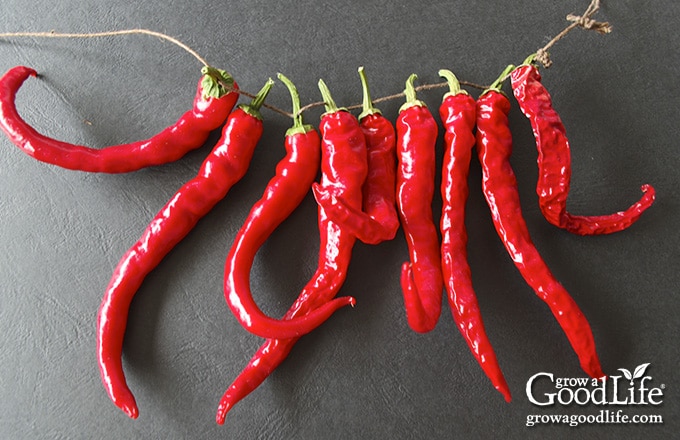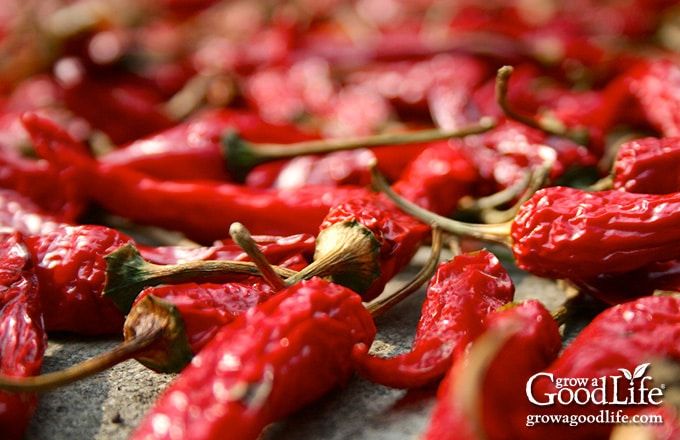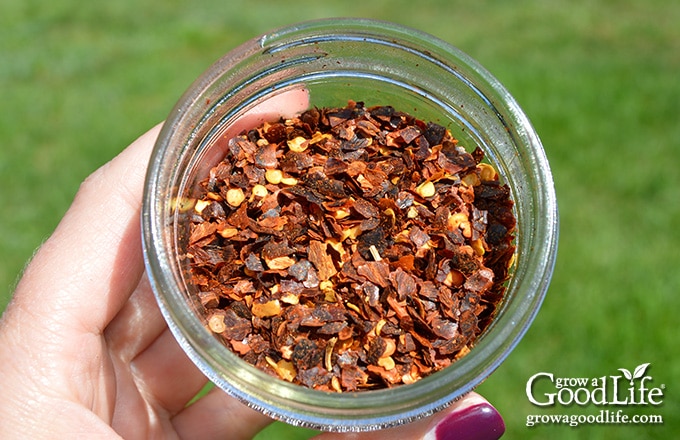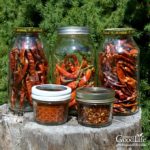3 Ways to Dry Peppers for Food Storage
This post may contain affiliate links, which means that I may receive a commission if you make a purchase using these links. As an Amazon Associate I earn from qualifying purchases.
Whether you found a great deal on peppers at the farmers market or harvested a bumper crop of chiles, you can turn that bounty into a shelf stable pantry staple that will add lots of flavor to your meals. Here are three ways to dry peppers for food storage.

Got peppers? Drying is an excellent way to preserve peppers. Dehydrating removes the moisture and concentrates the flavor and heat of the peppers.
Dried peppers are very versatile. They can be ground into powders, or rehydrated to use in sauces, soups, stews, and chilies.
Types of Chile Peppers that Dry Well
Any type of pepper can be dried for food storage. Here are some common peppers that work well when dried:
- Poblano Chiles: Anchos are the dried version of poblano peppers and they are one of the most widely used chiles in Mexican cooking. They are deep red in color, and have a mild, smoky heat flavor. Ancho chiles can be ground into chili powder using a spice grinder or rehydrated to use in red chile sauces.
- Cayenne Pepper: Cayenne peppers are the most common chile pepper used for crushed pepper flakes. After drying, cayenne peppers can be crushed into red pepper flakes, ground into cayenne chile powder, or rehydrated to use in recipes.
- Red Jalapeños: Chipotles are the smoked and dried version of red jalapeños. Red and green jalapeño chiles can also be dried without smoking. If you have a smoker follow this tutorial at Kevin is Cooking to infuse lots of smoky flavor, and then dry them for food storage. After drying, jalapeño peppers can be ground into powder or rehydrated to use in recipes.
- Paprika Chiles: Hot, sweet, smoked, plain, Hungarian, and Spanish paprika all taste distinctive depending on the types of peppers used.
- Smoked paprika is infused with natural woody flavor before drying and grinding into powder. This gives it a strong smoky flavor that’s perfect for some savory dishes and dry rubs for grilled meats. After drying, paprika chiles can be ground into powder or rehydrated to use in recipes.
- Chile de Arbol: These bright red peppers have a nutty, earthy, and very spicy heat that is perfect for adding a spicy kick. They are great ingredient for Mexican inspired recipes and pickling brines. After drying, chile de arbol peppers can be ground in a coffee grinder or spice mill or rehydrated to use in recipes. Try this simple Toasted Arbol Chile Salsa by Rick Bayless
- Sweet Peppers: Sweet peppers of every size and color can be dried too. I like to dehydrate bell peppers in small-diced pieces. It makes it so easy to grab a handful and add directly to soups and stews.
Hang and Air Dry Peppers
If you live in a dry climate with day temperatures above 85˚F (20˚C), air-drying is the easiest method to dry peppers.
Step 1: Prepare the peppers
Choose thin walled peppers for air-drying. Thicker peppers will not dry fast enough and may begin molding.
Select freshly harvested fruit with no insect damage or blemishes.
Step 2. Thread the peppers on string
Use a long needle and thread to string the peppers together through the stems. Leave plenty of space in between the peppers for airflow.
Step 3: Hang the peppers to dry
Hang your peppers to dry in an area with good airflow and sunshine. Depending on the humidity in the air, this method can take 3-4 weeks until the peppers are fully dry. Peppers are dried completely when brittle. Store fully dried peppers in airtight jars away from sunlight.

Dehydrate Peppers with a Food Dehydrator
Since our summers here are humid, the moisture in the air can prevent peppers from air-drying naturally. A food dehydrator is the quickest and easiest way for us to dry peppers. A dehydrator works by circulating a gentle flow of slightly heated air through screens.
Step 1: Prepare the peppers
Choose freshly harvested fruit with no insect damage or blemishes. Small chile peppers can be dried whole. Larger peppers will dehydrate quicker when cut into pieces. Use gloves when handling hot peppers, and cut them into uniform pieces.
Step 2: Place the peppers on the drying screens
Spread the peppers out on the screens and set the temperature between 125˚F and 135˚F (or per your food dehydrator’s instructions). Rotate the screens frequently and remove the peppers that are dry. The peppers are dried completely when brittle. Dehydrating time can take 4-12 hours depending on the peppers. Store the dehydrated peppers in glass jars away from direct light to preserve the color.
Dry Peppers in the Oven
Alternatively, peppers can be dried in the oven at a very low temperature.
Step 1: Prepare the peppers
Choose freshly harvested peppers with no soft spots. Cut larger peppers into uniform pieces so they dry quicker. Small peppers can be dried whole. Use gloves when handling hot peppers.
Step 2: Place the peppers on baking sheets
Spread the peppers out on baking sheets and place in a 150˚F oven. Leave the door open a crack to allow moisture to escape.
Check on the peppers every 30 minutes and rotate and remove the ones that are dry. Depending on the peppers, drying in the oven can take 1-2 hours. The peppers are dried completely when brittle. Store fully dried peppers in airtight jars away from sunlight.

Ways to Use Dehydrated Peppers
Dried peppers are very versatile. Add dried peppers directly to soups and they will rehydrate as it simmers. Rehydrate dried peppers and blend them into sauces and salsas. Blend dried peppers into flakes or powder and use it in your favorite recipes, spice blends, and dry rubs. Below are several ways to cook with dried peppers:
Add Dried Peppers to Slow Cooker Recipes
This is deal for slow cooked recipes such as soups, stews, or chilies that simmer for a long period of time. The peppers will rehydrate using the liquid in the pot. As the peppers rehydrate, they infuse their flavor into the liquid.
Rehydrate and Use in Recipes
- Remove the seeds: The seeds can add a slightly bitter flavor and texture preventing sauces from blending smooth. Removing the seeds while the pepper is dry is much easier than removing after rehydrating. While wearing gloves, use kitchen shears to snip the stems off the pepper, cut it in half, and shake out the seeds.
- Toast the dried peppers: Heat a skillet over medium-high heat. Drop in the dried peppers and toast them until they are fragrant, about 30 seconds on each side. Turn off the heat.
- Add boiling water and let the peppers soak: Add enough boiling water to the pan to cover the peppers and let them soak until they are rehydrated, about 15-30 minutes depending on how thick your peppers are.
Blend into Flakes or Powder
Most red pepper flakes and chili powder found in stores are made from cayenne and a mix of chile peppers. Sometimes they have been stored on shelves for so long that they lose their flavor. When you make your own crushed red pepper flakes, you can select the flavor and heat level by using hot or mild dried chiles. Pepper flakes don’t have to be red either. You can use any dried pepper for this spice, sweet or hot.
Many store bought chili powders are filled with additional ingredients including cumin, onion, garlic powder, and salt. Make you own pure chili powder with just pure ground dried chile peppers. You can combine different chile peppers to develop your own unique version.

How to Make Crushed Red Pepper Flakes
- Break up the dried peppers: Break up the dried peppers into smaller pieces. You can use your hands (wear gloves) or cut them with kitchen shears.
- Use a food processor: Add the pieces to the bowl of a food processor and pulse into smaller pieces. Store the crushed red pepper flakes in an airtight jar.
- Use red pepper flakes in spice blends, sprinkle on pizza, add to scrambled eggs, or on anything for extra flavor.
How to Make Chile Powder
- Break up the dried peppers: While wearing gloves, use kitchen shears to snip the stems off the pepper, cut it in half, and shake out the seeds. Cut the dried peppers into smaller pieces.
- Grind the pepper: Use a spice grinder or coffee grinder to blend the dried chile peppers into a powder and store in airtight jars.
- Use your homemade chile powder in your favorite recipes, spice blends, taco seasonings, and rubs.
How to Dry Peppers for Food Storage
Ingredients
- 1 pound hot chile peppers about 10 to 12 peppers
- 1 pound sweet bell peppers about 4 to 5 peppers
Instructions
Prepare the Peppers
- Choose healthy chilies and bell peppers with no insect damage or blemishes. Rinse well under clean water and air dry on a kitchen towel.
Air Drying Chili Peppers
- Choose thin walled hot peppers for air-drying. Thick bell peppers will not dry fast enough and may begin molding.
- Thread the chilies on string. Use a needle and thread to string the peppers together through the stems. Leave space in between the peppers for airflow.
- Hang the chili peppers to dry in an area with good airflow and sunshine. Depending on the humidity in the air, this method can take 3-4 weeks until the peppers are fully dry.
Dehydrating Peppers with a Food Dehydrator
- Small chilies can be dried whole. Bell peppers will dry quicker cut into pieces. Remove the stems, seeds, membranes, and cut bell peppers into uniform pieces.
- Spread the pieces out on the drying screens and set the temperature between 125˚F and 135˚F (or per your food dehydrator's instructions).
- Swap the screens frequently and remove the peppers that are dry. Dehydrating time can take 4-12 hours depending on the peppers.
Drying Peppers in the Oven
- Cut larger peppers into uniform pieces so they dry quicker. Small peppers can be dried whole. Use gloves when handling hot peppers.
- Spread the peppers out on baking sheets and place in a 150˚F oven. Leave the door open a crack to allow moisture to escape.
- Check on the peppers every 30 minutes and rotate and remove the ones that are dry. Depending on the peppers, drying in the oven can take 1-2 hours.
Storing Dried Peppers
- Peppers are dried completely when brittle. Store fully dried peppers in airtight jars away from sunlight.
Nutrition
The next time you snag peppers at the farmers market or harvest a bumper crop of chiles, turn that bounty into a pantry staple that will add lots of flavor to your meals.
Think about the types of dried peppers you enjoy using in your cooking and grow a few plants. Here are some tips for growing peppers in cooler climates.
This article was originally published on September 14, 2016. It has been updated with additional information and photos.
You May Also Like
Good planning is key to a successful vegetable garden
Whether you are new to growing your own food or have been growing a vegetable garden for years, you will benefit from some planning each year. You will find everything you need to organize and plan your vegetable garden in my PDF eBook, Grow a Good Life Guide to Planning Your Vegetable Garden.



I’ve been growing my own organic fruits and vegetables for over 5 decades but previously only freezing or canning. I bought a dehydrator since I no longer have the extra big freezers I had before I retired.
Since I don’t like spicy food, I started drying my own mild Habanada, Cubanelle and Banana peppers to make mild chili oil and chili powder. After spending hours cutting and removing seeds, preparing my peppers for dehydrating, I found your website to learn how to hang peppers to dry them. Obviously that won’t work in Florida. But I also found your exceptional website which is one of the best I have found so far.
Cindy, Your comment made my day! Thank you! Hanging peppers to dry is also tricky in Maine because of the high humidity we have at the end of summer. I have to use a dehydrator to dry most of my peppers, or they will spoil.
I live in NM (high desert, low humidity). To dry chiles, I just leave them with good airflow on my counter or just place them in a brown paper bag. I also dry sliced mushrooms and herbs like cilantro, parsley, basil, etc that way. Nothing gets wasted if not consumed fresh. Just dry them out. If people would just spend a little bit of time, there wouldn’t be as much food waste. Hope others will try to be more frugal.
Thanks!